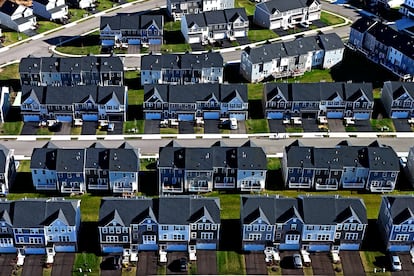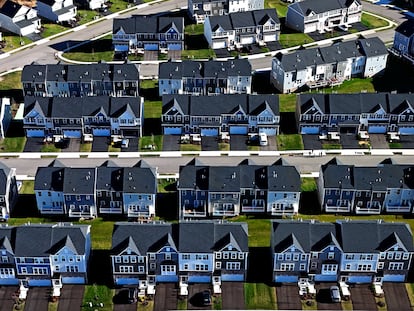America’s housing crisis is at the heart of the economic pessimism affecting this election
Correcting low supply and high prices has become one of the main stated goals for both presidential candidates, who are aware this is one of voters’ biggest concerns

Something is wrong when finding a reasonably affordable rental is viewed as a miracle. It is part of everyday life in New York, the most stressed market in the country, but it is also an increasingly present reality from coast to coast. In the United States, when people start looking for a new home, it is no longer hope for the future that dominates their mood, but anguish, stress and uncertainty. And these feelings are not easily forgotten when the time comes to choose a presidential candidate.
Giovanna Drummond experienced this feeling this summer. After getting a postgraduate degree, she moved to New York because it was where she saw the best possibility of career growth. The ideal place would be an apartment for one in a well-connected area and at a reasonable price — the average for this type of property in New York is around $3,500 — but she knew that this was most likely a pipe dream.
Like any millennial, she turned to the internet to help with her search: real estate websites, Craigslist, Facebook. The task is a constant grind that entails endless scrolling, discarding “deals” that are too good to be true, too expensive, too far away, too small. And when a decent ad briefly lands on the screen, that’s when it’s time to act by contacting the owner or agent, scheduling an appointment, viewing the apartment and putting in an offer — all within a period of a few days with some luck, but sometimes just hours.
Most viewings come to nothing. “I went to see an apartment and it didn’t look anything like the photos. It was a basement and it was dirty. I asked if they were going to paint it and they said ‘it’s already been painted and cleaned. ’ I’m sure there are plenty of people desperate enough to say, ‘ok, I’ll take it. ’ I’m lucky to have the support of my parents at this stage, but the pressure still gets to me, with landlords telling me ‘you have to make up your mind now because I have six other people who are interested,’” Drummond says, knowing that this could very well be a lie. It’s been widely accepted by now that finding a decent rental these days is a psychological game that includes additional fees for agents, security deposits and advance payments that can add up to several thousand dollars.
Taken together, the housing market has become a kind of collective trauma of national dimensions. And this is happening against the backdrop of an election year in which the economy is the main concern of voters due to the very high cost of living, which has become an essential characteristic throughout the country since the Covid pandemic. Breaking down what sustains this economic pessimism, housing stands out as one of the two biggest concerns, being the largest monthly expense for any family or individuals in the country — the other being the price of groceries, the most recurring expense.

Candidates Harris and Trump know this very well and talk about it non-stop. It was one of the first major platforms of the Democratic candidate’s nascent campaign. The vice president’s proposal aims to be holistic, addressing problems on both the demand and supply sides. On the one hand, she has proposed a direct aid of $25,000 so that potential first-time buyers can access a mortgage, as well as a less specific promise to support and expand existing local rental support programs. On the other hand, to expand supply, which basically means building more homes, Harris proposes aggressive deregulation to be able to erect taller buildings that make better use of space than the average American single-family home, in addition to freeing up state land for construction and implementing a series of tax incentives for builders. Trump, for his part, has briefly proposed through his convoluted speeches and public appearances something very similar to the deregulation and tax incentives that Harris is proposing.
The proposals — all of which are extremely popular with the public according to surveys, although they have not been broken down in detail and could have undesirable effects on the market — show that the candidates are aware of the fundamental problem: there is a deficit of between four and seven million homes. The problem began with the Great Recession that followed the 2008 crisis, which, originating in a real estate bubble, hit the sector particularly hard. Since then, the pace of construction has never picked up, and year after year demand has put more and more pressure on supply, resulting in ever higher prices.
By 2022, nearly half of American households were paying more than 30% of their income on rent. Among them, the lowest-income 75% — those earning less than $15,000 a year, or about 10.5 million households — spend more than half of their income on rent.
The situation has reached its current state in the wake of the pandemic. With low interest rates, high savings rates and changes in work dynamics — mainly the expansion of remote work — the market, both for renting and buying, overheated. People were looking for better housing in cities that were already in high demand, or for larger houses in medium-sized or small cities and in rural areas. The boom in demand pushed up prices everywhere.
And then inflation came along to distort the picture even further. Construction costs, which had already risen due to problems in global supply chains caused by Covid restrictions, rose further and were passed on to the final buyer or tenant. In order to maintain profit margins, construction companies have chosen to prioritize the most expensive market, the only segment where supply has grown.
But rising construction prices aren’t the only reason Americans are having to pay more for homes. To combat the same inflation that had driven up costs, the Federal Reserve raised interest rates and has kept them high — though it’s expected to lower them later this month for the first time since 2022. Going from 0% or even negative interest rates, as they were in the first two decades of the century, to the current rate of 5.5%, has had an effect on mortgages. Right now, fixed rates for a 30-year mortgage are hovering around 7%. In real terms, this means that, on average, for a working or middle-class family, the monthly payment has nearly doubled, according to data from the National Association of Realtors. And that’s only if the family has been able to save enough to make a down payment on the mortgage — something that is increasingly unlikely given the cost of rent.
Latinos in the United States are a segment of the population that is particularly affected by this set of conditions, explains Laura Arce, senior vice president of Economic Initiatives at UnidosUS, the largest national Hispanic civil rights organization, and previously a senior vice president for Wells Fargo & Co. “There is still a very large gap between the homeownership rates of the white population versus Latinos, and that has to do with systemic barriers at a broad level. For example, there is a greater concentration of the Latino population in places like California, Florida or New York, which are extremely expensive markets. In addition, Latinos tend to be employed in sectors with lower wages.” Latinos also have less family wealth that would allow them to access housing, less economic literacy to navigate the available financing options and in many cases they do not have a credit history, which “in the United States is the same as having a negative credit history.”
Arce, who designed and leads UnidosUS’ Home Ownership Means Equity (HOME) program, a long-term movement to transform the economic trajectory of Latinos through homeownership, stresses that they heartily welcome the fact that candidates are talking about the issue as a priority in this election cycle. “It is a sign and it shows that access to housing is not just an issue in cities on both coasts, nor a problem only for low-income people. It is affecting everyone.”
Sign up for our weekly newsletter to get more English-language news coverage from EL PAÍS USA Edition
Tu suscripción se está usando en otro dispositivo
¿Quieres añadir otro usuario a tu suscripción?
Si continúas leyendo en este dispositivo, no se podrá leer en el otro.
FlechaTu suscripción se está usando en otro dispositivo y solo puedes acceder a EL PAÍS desde un dispositivo a la vez.
Si quieres compartir tu cuenta, cambia tu suscripción a la modalidad Premium, así podrás añadir otro usuario. Cada uno accederá con su propia cuenta de email, lo que os permitirá personalizar vuestra experiencia en EL PAÍS.
¿Tienes una suscripción de empresa? Accede aquí para contratar más cuentas.
En el caso de no saber quién está usando tu cuenta, te recomendamos cambiar tu contraseña aquí.
Si decides continuar compartiendo tu cuenta, este mensaje se mostrará en tu dispositivo y en el de la otra persona que está usando tu cuenta de forma indefinida, afectando a tu experiencia de lectura. Puedes consultar aquí los términos y condiciones de la suscripción digital.
More information
Archived In
Últimas noticias
Welcome to the post-religion era: The idea of Christianity as the absolute truth has become obsolete
‘I thought you would like it’: The risky sexual practice popularized by TV shows and TikTok
The digitalization of tourism: ‘They promise experiences and gave us the worst possible one’
Mexican peso defies uncertainty with forecasts of a new period of stability in 2026
Most viewed
- Sinaloa Cartel war is taking its toll on Los Chapitos
- Oona Chaplin: ‘I told James Cameron that I was living in a treehouse and starting a permaculture project with a friend’
- Reinhard Genzel, Nobel laureate in physics: ‘One-minute videos will never give you the truth’
- Why the price of coffee has skyrocketed: from Brazilian plantations to specialty coffee houses
- Silver prices are going crazy: This is what’s fueling the rally











































